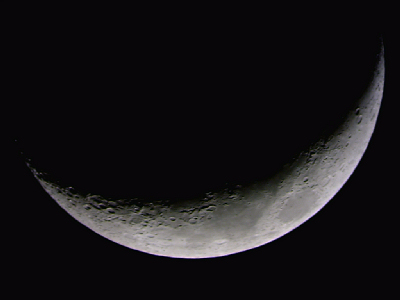
If you hang around with anyone who does astrophotography, you'll recognize the term "First Light." This is an affectionate name for the image of the first "real" subject photographed with a new piece of equipment, after testing and calibration. The Moon photo above is the "First Light" image taken with my new telescopic camera -- for my birthday, Kathy gave me a telescope eyepiece imager.
This solves a problem I have been struggling with, i.e. how to connect my camera to the telescope. There are two options: 1) Placing the camera, sans lens, at the telescope's prime focus; 2) Placing the camera, with a normal lens, pointing into a regular telescope eyepiece. Unfortunately, #1 creates a small image with my telescope (not much better that what I could get with a regular telephoto); #2 requires near-perfect alignment, has vignetting, and focusing is very problematic. Both methods make it very difficult to aim the telescope since the camera is in the way, hindering normal eyepiece viewing.
Over the years, serious hobby astrophotographers have solved these problems with custom cameras designed for telescopes, connected to a computer via a data cable. Recently, quality telescope imagers have come down in price for mere mortal astrophotographers like me. Well, "quality" is relative of course. For $100, you can get a 1024 x 768 resolution sensor in a 5mm eyepiece, resulting in a magnification (for my telescope) of 100x or 200x -- enough to get me started on imaging objects in the solar system -- starting with the Moon.
First Light images are often lower quality than the eventual results from the new device. For example, the first Hubble Space Telescope images revealed a manufacturing flaw which eventually required a Shuttle mission to apply the telescopic equivalent of eyeglasses.
In my case also, the images will get better over time. For example, a night with a more stable atmosphere will help (better "seeing"), as will getting the hang of focusing using a computer screen. With my barlow lens, I'll be able to effectively double the resolution by getting in closer. Also, I need to experiment more with the imager controls, e.g. constrast, brightness, and gain. Then there is the post-processing -- learning the Registax interface better in order to best find the "good" frames and tweak the many stacking and wavelet parameters.
But for now, I can sit back and enjoy this inaugural photograph of Earth's closest neighbor, taken through my own telescope. :-)

No comments:
Post a Comment